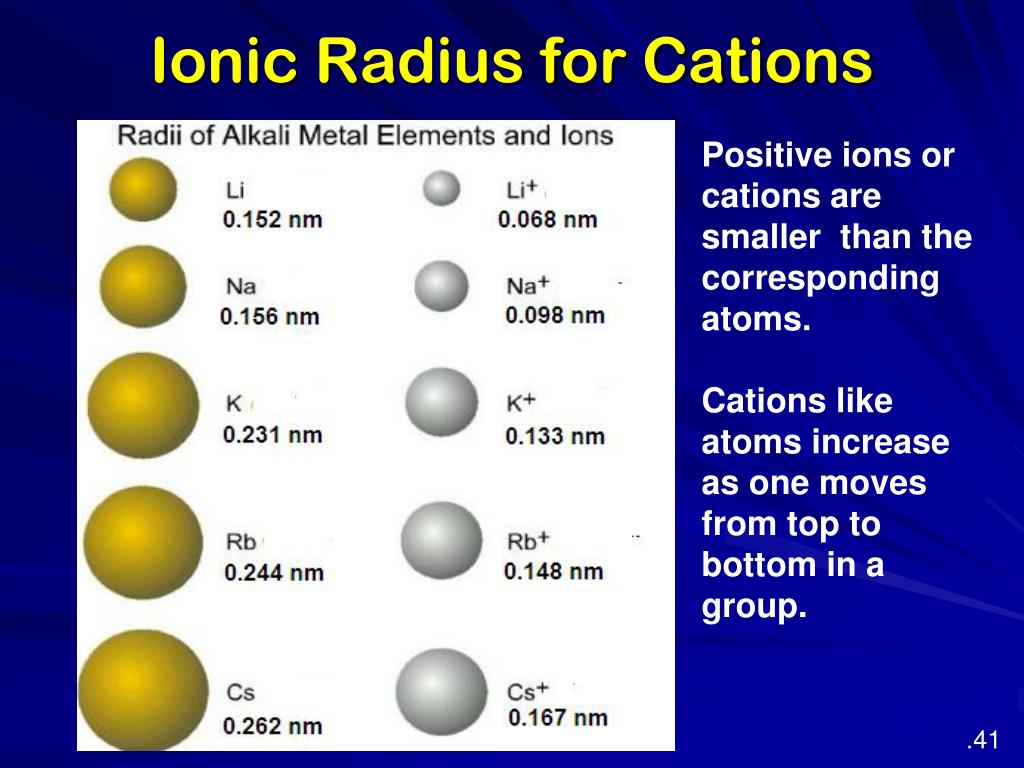
Let us explain this method by calculating the ionic radii of Na + and F - in NaF crystal whose interionic distance is equal to 231 pm. The analysis of the structure of LiI was based on the following assumptions. Take out your straws and lay them in order of. The first ionic radii were obtained by studying the structure of LiI, which contains a relatively small positive ion and a relatively large negative ion. Atomic and ionic radii are found by measuring the distances between atoms and ions in chemical compounds. For metals ( Families 1 - 4 ) the atomic radius is larger than the ionic radius. On solving equation (1) and ( 4 ) the values of r C + and r A- can be obtained The Size of Atoms: Ionic Radii The relative size of atoms can also be studied by measuring the radii of their ions. Where Z eff is the effective nuclear charge and Z eff = Z - S Consider for example the compounds MgX and MnX, where X O, S, Se. This page explains the various measures of atomic radius, and then looks at the way it varies around the Periodic Table across periods. Pauling also assumed that the radius of the ion having noble gas electronic configuration (Na + and Cl -having 1s 2 2s 2, 2p6 configuration) is inversely proportional to the effective nuclear charge felt at the periphery of the ion. Ionic radii depend on oxidation state (higher charge > smaller cation size, larger anion size) We can build up a table of ionic radii by assuming that the bond length is the sum of the radii (r + + r -) if the ions are in contact in the crystal. Where d is the distance between the centre of the nucleus of cation C + and anion A - and r C +, r A - are the radius of the cation and anion respectively. The rule states that the higher the ionic radius, the higher the. 6 When formed, ionic atoms change in size with respect to their orginal atom. The solid lines connect lithophile and chalcophile + siderophile ions with the same. Pauling assumed that ions present in a crystal lattice are perfect spheres, and they are in contact with each other therefore, In a crystal lattice, the ionic radius is a measure of the size of the atoms ion. The ionic radius increases on decending a group as would be expected with the increasing number of electron shells. Ionic radius of uni-univalent crystal can be calculated using Pauling's method from the inter ionic distance between the nuclei of the cation and anion. (a) The internuclear distance is apportioned between adjacent cations (positively charged ions) and anions (negatively charged ions) in the ionic structure, as shown here for \ce.It is defined as the distance from the centre of the nucleus of the ion up to which it exerts its influence on the electron cloud of the ion. Ionic radius, rion, is the radius of a monatomic ion in an ionic crystal structure.

As you move from left to right across an element period (row) the ionic radius decreases. Trend: If you gain electrons ANION IR with respect to neutral atom. Ionic radius and atomic radius follow the same trends in the periodic table : As you move from top to bottom down an element group (column) ionic radius increases. The designations cation or anion come from the early experiments with electricity which found that positively charged particles were attracted to the negative pole of a battery, the cathode, while negatively charged ones were attracted to the positive pole, the anode.įigure 4.5.1. This relates to AR but instead of a neutral atom, we have an ion.

To predict relative ionic sizes within an isoelectronic series.Īn ion is formed when either one or more electrons are removed from a neutral atom to form a positive ion (cation) or when additional electrons attach themselves to neutral atoms to form a negative one (anion).


 0 kommentar(er)
0 kommentar(er)
